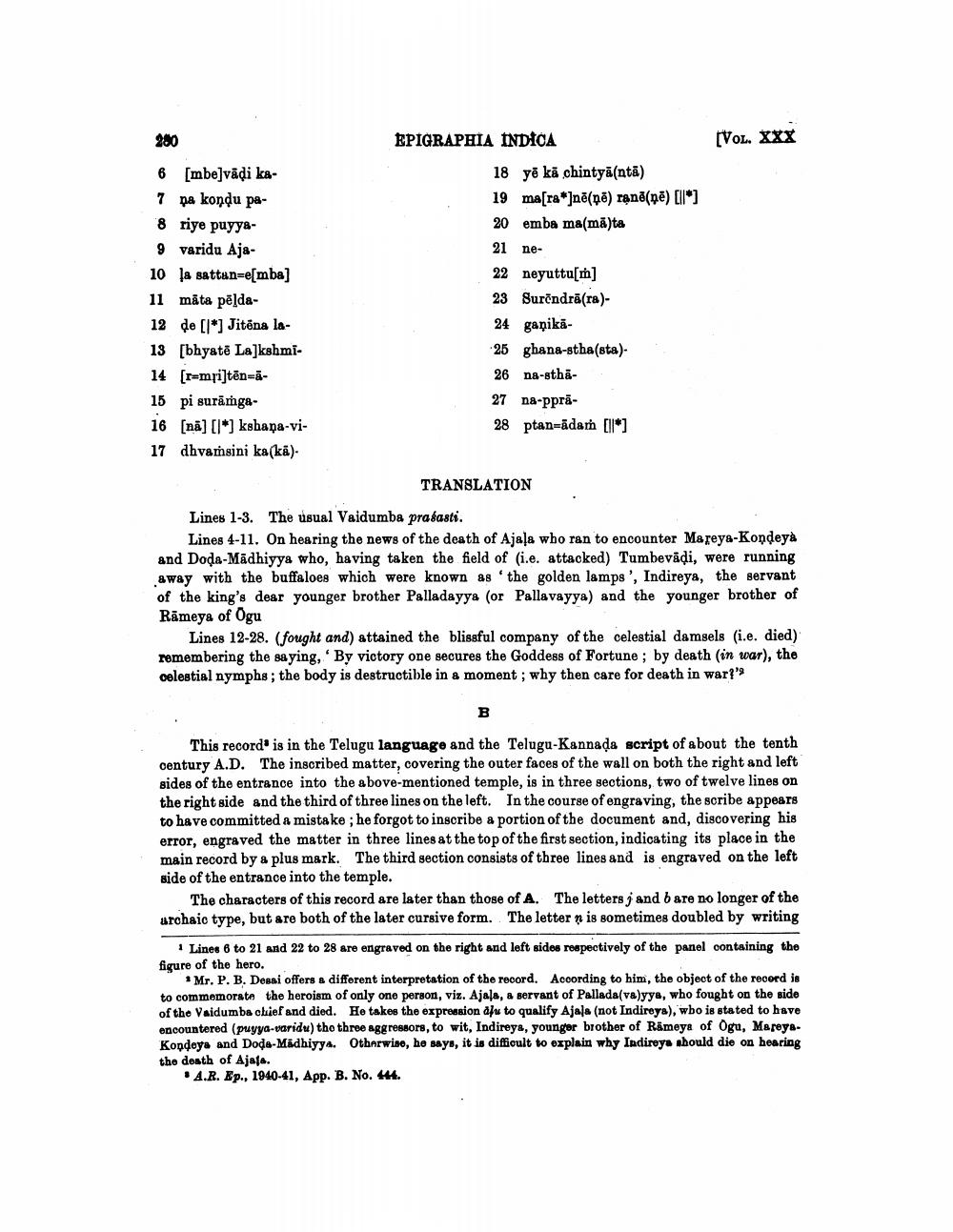________________
280
EPIGRAPHIA INDICA
[VOL. XXX
6 [mbe]vādi ka7 na kondu pa8 riye puyya9 varidu Aja10 la sattan=e[mba) 11 māta pē]da12 de [l*] Jitēna la13 [bhyatē La]kshmi14 [r=mri]tēn=ā15 pi surāmga16 [nā] [l*) kshana-vi17 dhvamsini ka (kā)
18 yē kā chintyä(ntā) 19 ma[ra*)nēspē) rạnē(nē) [ll*] 20 emba ms(mā)ta 21 ne22 neyuttu[m] 23 Surendrā(ra)24 ganika25 ghana-stha(sta) 26 na-stha27 na-ppra28 ptan=ādar [ll]
TRANSLATION
Lines 1-3. The usual Vaidumba prasasti.
Lines 4-11. On hearing the news of the death of Ajaļa who ran to encounter Mareya-Kondeyà and Doda-Madhiyya who, having taken the field of (i.e. attacked) Tumbevádi, were running away with the buffaloes which were known as the golden lamps', Indireya, the servant of the king's dear younger brother Palladayys (or Pallavayya) and the younger brother of Rāmeya of Ogu
Lines 12-28. (fought and attained the blissful company of the celestial damsels (.e. died) remembering the saying, 'By victory one secures the Goddess of Fortune ; by death (in war), the celestial nymphs; the body is destructible in a moment; why then care for death in war?"
This record is in the Telugu language and the Telugu-Kannada script of about the tenth century A.D. The inscribed matter, covering the outer faces of the wall on both the right and left sides of the entrance into the above-mentioned temple, is in three sections, two of twelve lines on the right side and the third of three lines on the left. In the course of engraving, the scribe appears to have committed a mistake; he forgot to inscribe & portion of the document and, discovering his error, engraved the matter in three lines at the top of the first section, indicating its place in the main record by a plus mark. The third section consists of three lines and is engraved on the left side of the entrance into the temple.
The characters of this record are later than those of A. The letters and b are no longer of the urchaic type, but are both of the later cursive form. The lettern is sometimes doubled by writing
Lines 6 to 21 and 22 to 28 are engraved on the right and left sides respectively of the panel containing the figure of the hero.
Mr. P. B. Desai offers a difforent interpretation of the record. According to him, the object of the record is to commemorate the heroism of only one person, viz. Aja!s, & servant of Pallada(va)yya, who fought on the side of the Vaidumba chief and died. Ho takes the expression afu to qualify Ajals (not Indireys), wbo is stated to have encountered (puyya-varidu) the three aggressors, to wit, Indireys, younger brother of Rämeya of Ogu, MareyaKondeya and Doda-Mädhiyya. Otherwiso, he says, it is difficult to explain why Indireya should die on hearing the death of Ajafa.
.A.R. Ep., 1940-41, App. B. No. 14.




